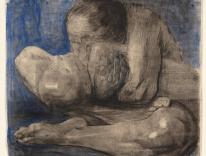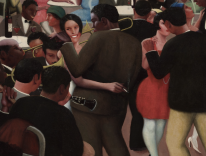It is a truth only rarely acknowledged that, when an artist succeeds, their peers will smile and applaud and then, after a few drinks, begin to gripe behind their back. The industry is harsh, the market harsher, and under that kind of pressure, friendships compress into rivalries and respect curdles into resentment. Not that anyone likes to admit this, of course; we are all thrilled for our friends, and we would never begrudge the light their successes shed on our own. And so the resentment must leak out through memoirs and essays, in novels filled with thinly veiled versions of real-life artists, or in a snooty review.
Occasionally, however, it comes rushing out in a literal hatchet job. In 1868, Edgar Degas painted a domestic portrait for his friends Edouard and Suzanne Manet. On the left side, Monsieur Manet lounges idly across the couple’s couch, chin in palm and ankle resting idly on a cushion, the pantleg rising just enough to show off his rust-colored socks. Madame sits in profile on the right, her long striped skirts gathered beneath her as she sits at the piano. The painting’s sketchy, smudged surfaces and soft contours impart an effect both vigorous and languid. Which is to say: it’s a Degas. Yet this seems not to have been enough for Manet. Some years later, Edouard slashed the painting with a razorblade, slicing down through the image of his wife’s face to remove everything past her cheekbone. Degas took the painting back, and pasted on another patch of canvas, perhaps hoping he could restore it. He never did, leaving us with the image of a woman occluded, as if hiding her face behind a corner.
This painting hangs in the first room of the Metropolitan Museum of Art’s blockbuster “Manet/Degas” exhibition. On the opposite wall are seven sketches, etchings, and ink portraits made by the Degas of the Manet’s bushy beard and heavy stare. Born two years apart at the beginning of the 1830s, these two titanic artists developed an intimate but fraught relationship, combative enough for one to have mutilated the other’s work, and close enough that this outburst was forgiven.
The two men met at the Louvre, where Degas was copying Velazquez’s portrait of the “Infanta.” From an early age, he took to the softly shaded outlines of the Spanish and Dutch renaissance, a portraiture rich in veiled gazes and deep backgrounds. His 1861 etching of the “Infanta” sets her in a shadowy box full of fine details, her bored glare piercing through everything. In a pair of etchings from the same period, Manet simplifies the same image down to a series of strong lines. Degas recreates the painting; Manet transforms it.
This contrast of styles persists throughout the show. Manet took what he wanted from Velazquez—darkness, staginess, strength of characterization—and extended it to modern Paris. Even in crowd scenes, his figures appear to be frozen, as if he had posed a clutch of mannequins in the city streets. Manet discovered early on the power artifice has to heighten human beauty. His “Olympia” poses with the still grace of a statue, drawing your eye in toward those points where life pokes through: the red blush beneath her lemon-white skin, the crevice where one leg rests on another, the dimpling where the fingers of her left hand press down into her thigh. Manet’s paintings hold the staged tableaux and the real world in an unresolved tension; the shock is electric.
Degas handled this same tension differently, pairing his mastery of the human form with the mud-stained streetscapes of modern Paris. Yet Degas’ radical approach took longer to develop, and while Manet was exhibiting at the Salon, his friend was mucking around with unconvincing genre paintings and accomplished but unexciting Dutch-inspired portraits. Manet adapted classical forms to his own purposes, portraying Christ as a corpse, for example, or a prostitute as a goddess. Degas had to find his own perspective. His best early paintings are interiors, private scenes in which a sitter is overshadowed by his or her environment: a bouquet of wilting flowers, say, or a portfolio of prints. Degas anonymizes his subjects, transforming them into types or roles—hence his love of the theater and ballet, where an individual is subsumed into her performance, and the costume takes center stage.
Degas exemplifies the fundamental rule of modern art: not what, but how. And how! Where Manet worked largely to perfect a distinctive and narrowly focused technique, Degas moved restlessly in many directions, experimenting with pastel, lithography, sculpture, and photography, approaching the same subjects—the racetrack, the opera, a woman bathing at home—from various perspectives and with various materials. In one representation of his cousins’ cotton office in New Orleans, he takes care to fill in each figure, down to the most trivial details: a dangling cigarette, a sunburned face, the orange blush of a mustache peeking above a pile of crumpled papers. In another painting of the exact same office, each element—from the man in his straw boater to the naval painting on the wall—appears sketchy and blurred, and the color is so thinly applied that the underdrawing shows through. These two paintings could be from different artists, or different centuries, yet Degas painted both in 1873.
His creativity was relentless, the output of an impatient, impudent mind egging itself on. As “Manet/Degas” shows, Degas’s energy also spurred the people around him, not least his friend Manet. The Met has hung the paintings both chronologically and thematically, illustrating the conversation both artists had with the world and one another. Both men were drawn to the racetrack, and visited together; Manet even makes an appearance in Degas’ “The Racecourse, Amateur Jockeys.” Degas’ fluid style was well suited to the horses and their jockeys, capturing their rapid motion with flat, blended colors. Manet’s style, working on the same kind of scene, is a considerably stranger fit. His paintings seem to freeze the horses mid-stride, sapping them of their dynamic vitality. Meanwhile, the crowds watching the race appear to be composed of alienated, disconnected figures.

Manet found fame early, and even when a group of his friends (Degas included) broke away to host their own impressionist exhibitions, he chose to debut his work at the prestigious Salon. Yet by presenting their work together, “Manet/Degas” shows how Edouard loosened up as he became less bound to the studio. His paintings of actresses, barmaids, and cafés are full of a bustling, sketchy energy. A pastel illustration of a bathing woman gestures more to Munch than to Rembrandt. “The Café-Concert” foregrounds minutiae—cigarettes, napkins, half-full glasses of beer—and displaces the actual concert onto a mirror in the background, an unusual device that owes plenty to Degas’s seedy café-culture paintings. Seen side by side, the paintings of Manet and Degas correspond and collaborate, leaping one over the other in productive rivalry. The effect is exhilarating.
“Manet/Degas” tells the story of two lives and one friendship. Manet died in 1883, Degas in 1917. Edouard used those extra thirty-four years to experiment, evolve, and become immensely famous, until he far eclipsed his dead friend’s frozen legacy. Yet he also worked to consolidate that legacy. At Manet’s funeral, Degas described him as “greater than we thought.” Degas collected Manet’s work, and exhibited alongside him internationally. He also began to purchase fragments of Manet’s grand 1868 “The Execution of Maximilian,” a painting that the artist himself had dismembered after it was rejected by the Academy. Having gathered the fragments, Degas carefully reassembled them on a new canvas. Once again, he found himself repairing a painting his friend had done his best to destroy.
Please email comments to [email protected] and join the conversation on our Facebook page.
Previous Story
Christmas Critics 2023
Next Story
The Jurisprudence & Politics of Abortion


